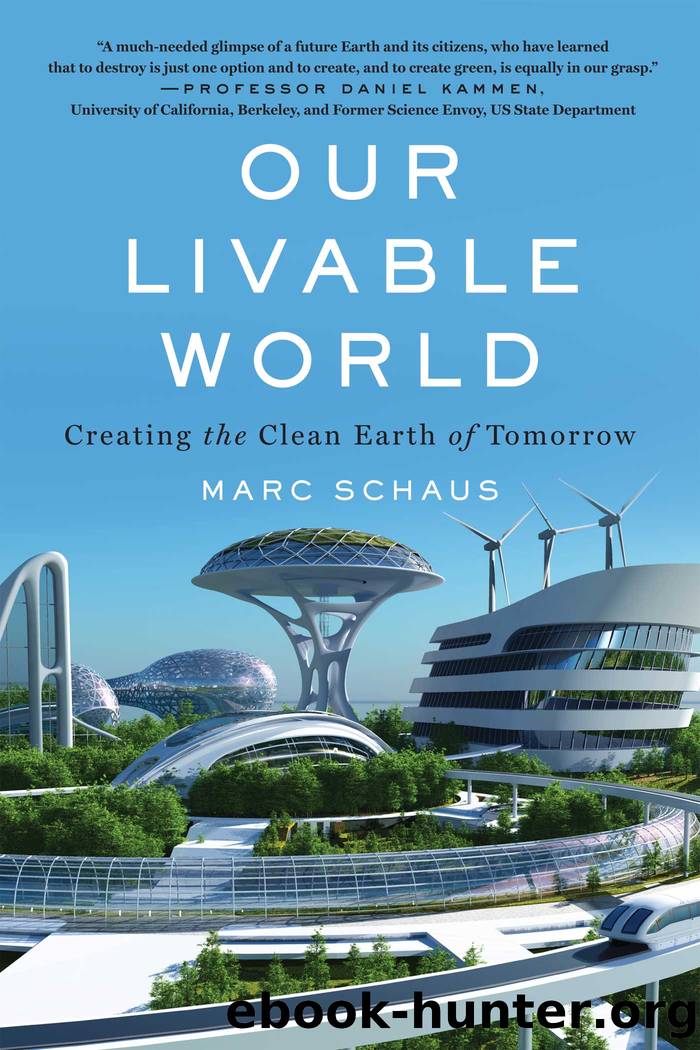Our Livable World by Marc Schaus

Author:Marc Schaus
Language: eng
Format: epub
Tags: General Fiction
Publisher: Diversion Books
Published: 2020-08-03T16:00:00+00:00
Meating Our Climate Goals
Clearly, we need to re-think how we grow our food. But beyond fruits and vegetables, other aspects of our food production system carry oversized energy and carbon emissions costs. Producing meatâessentially any kind of meatâcarries a particularly huge footprint in terms of energy cost and carbon emissions. Fortunately, advanced new sciences and technologies can again lower both to sustainable levels.
By now, youâve probably heard that meat production is an incredibly wasteful use of our land and poses numerous environmental problems. A growing number of meat-eaters worldwide will make these problems worse. We hear these points on the news and on our social media feeds; from our friends and our favorite celebrities and artists. In fact, as I was writing this section, pop stars Beyoncé and Jay-Z were offering their fans free tickets for life (or 30 years, anyway) in a campaign to get more people onto a plant-based diet. Events like âVeganuaryâ were just picking up steam and more and more people were trying out âBeyond Meatâ burgers at local fast food chains.
Many of us consume far more meat than we need to. Which, in terms of the resources going into producing our calories, is spectacularly wasteful. Every piece of meat we consume necessitates that land has been used somewhere to grow and care for the animal it came from. It involves the footprint of their housing and well-being, the processing and shipping of those animals and keeping everything cooled the entire way.
Every aspect of meat production carries its own associated energy and emissions cost. As Bill Gates noted on his blog back in 2018: if âcattleâ were its own country, it would currently rank third overall in carbon emissions.52 Resource-wise, depending on the animal, producing one pound of meat protein with Western industrialized methods requires 4 to 25 times more water, 6 to 17 times more land, and 6 to 20 times more fossil fuels than producing a pound of plant protein.53
We also sacrifice the land being used to raise animals for meat consumption. This is land often cleared for livestock owners through a razing of forested areas crucial for our planetâs health. In fact, Project Drawdown Executive Director Jonathan Foley cited tropical deforestationâoften undertaken so land prospectors can raise livestock or grow crops to feed other livestockâas potentially the number-one source of greenhouse gases from land use and agriculture.54 Which makes sense, if all the carbon stored in trees is simply being released back into the atmosphere.
Only about 18 percent of our calories come from meat and dairyâeven as those two calorie sources take up 83 percent of our farmland.55 Incredibly, almost 30 percent of the worldâs ice-free land is now used to raise livestock.56
It should be no surprise, then, that given our energy costs associated with meatâand given our carbon costs especiallyâacademics worldwide are calling for us to reduce meat consumption as much as we can. One letter signed by more than 50 leading scientists published in Lancet recently argued that the world must
Download
This site does not store any files on its server. We only index and link to content provided by other sites. Please contact the content providers to delete copyright contents if any and email us, we'll remove relevant links or contents immediately.
The Lonely City by Olivia Laing(4113)
Animal Frequency by Melissa Alvarez(3750)
All Creatures Great and Small by James Herriot(3508)
Walking by Henry David Thoreau(3228)
Exit West by Mohsin Hamid(3174)
Origin Story: A Big History of Everything by David Christian(3133)
COSMOS by Carl Sagan(2944)
How to Read Water: Clues and Patterns from Puddles to the Sea (Natural Navigation) by Tristan Gooley(2849)
Hedgerow by John Wright(2772)
The Inner Life of Animals by Peter Wohlleben(2763)
Origin Story by David Christian(2677)
How to Read Nature by Tristan Gooley(2657)
Project Animal Farm: An Accidental Journey into the Secret World of Farming and the Truth About Our Food by Sonia Faruqi(2656)
How to Do Nothing by Jenny Odell(2640)
A Forest Journey by John Perlin(2584)
Water by Ian Miller(2579)
The Plant Messiah by Carlos Magdalena(2451)
A Wilder Time by William E. Glassley(2358)
Forests: A Very Short Introduction by Jaboury Ghazoul(2331)
